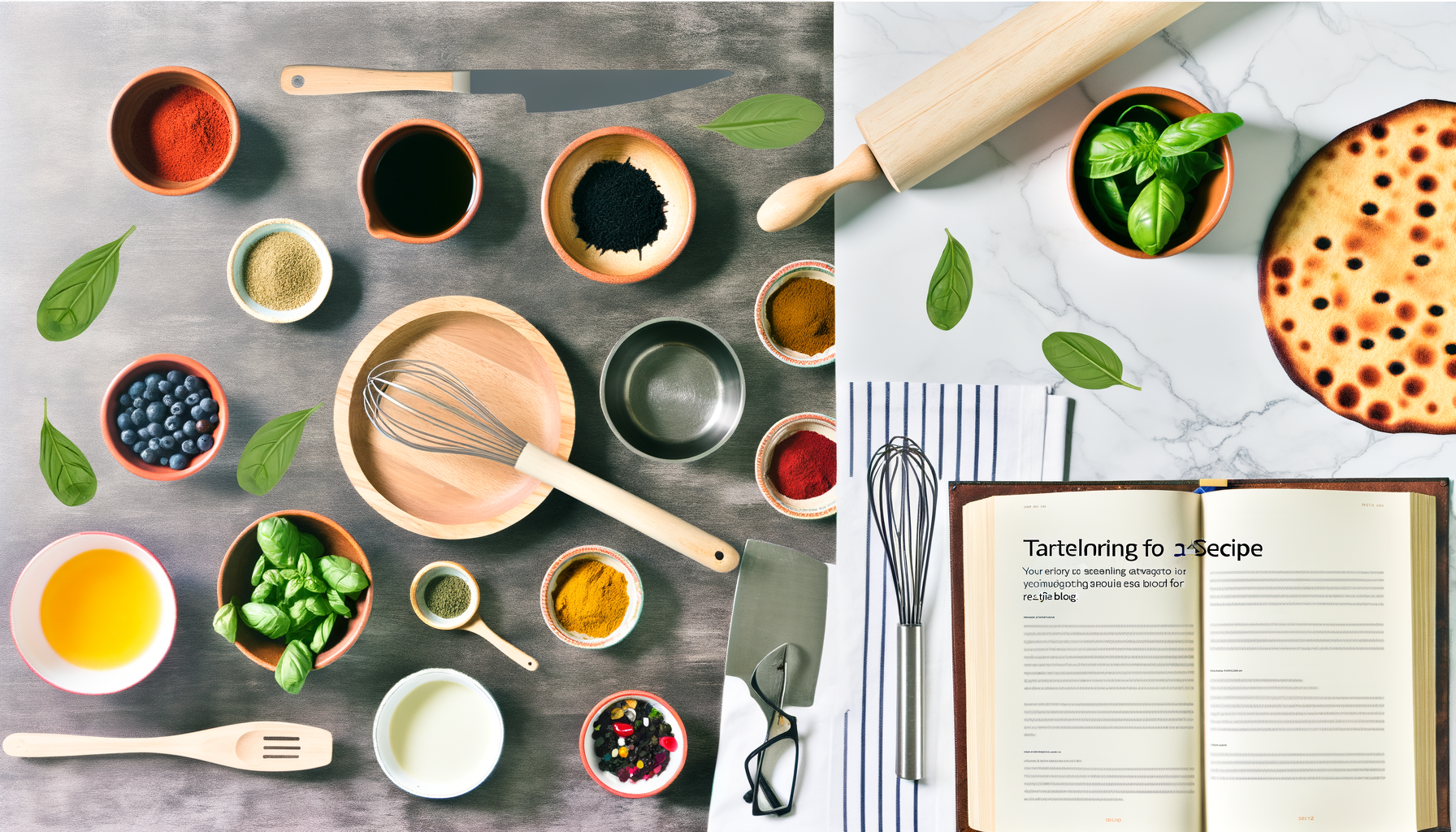
Optimizing a recipe blog for SEO involves a combination of standard SEO practices and niche-specific strategies. Precisely, to ensure your recipe content ranks well in search engines, it’s critical to conduct keyword research, optimize on-page elements, improve website speed, create high-quality content, and ensure your website is mobile-friendly. Moreover, utilizing structured data for recipes can provide rich results in search engines, improving click-through rates.
Now, let’s go more in-depth with a comprehensive guide to making your recipe blog a delicious treat for both readers and search engines.
Keyword Research and Content Strategy
Begin by understanding what your audience is searching for. Use keyword research tools to find popular search terms related to recipes. Look for long-tail keywords, which are less competitive and more specific. For example, “gluten-free banana bread recipe” might be a better target than the broader term “banana bread.”
Content Calendar and Seasonality
Create a content calendar that leverages seasonality – think pumpkin recipes in autumn and salads in summer. This ensures your content is timely and more likely to be searched for at certain times of the year.
Optimizing On-Page Elements
Each recipe page on your blog should be finely tuned with SEO best practices. This includes:
Title Tags
Title tags should include your primary keyword and be enticing to readers. They’re the first impression your content makes on potential visitors from a search engine results page (SERP).
Meta Descriptions
Meta descriptions provide a brief summary of your recipe. They should be compelling, include primary and secondary keywords, and motivate users to click on your link.
Header Tags
Use header tags (H2, H3, etc.) to structure your content, making it easy to read. Headers should also include relevant keywords where appropriate.
Image Optimization
Images are a critical component of any recipe blog. Ensure that images are compressed for fast loading and use descriptive file names and alt text with relevant keywords. This helps search engines understand and index your images properly, which can improve rankings and visibility in image searches.
Creating High-Quality Content
Your content must provide value to your readers. Recipes should be detailed with clear instructions, ingredient lists, and high-quality images. Go a step further by adding tips, nutritional information, and variations of the recipe to cater to different dietary needs.
Engage Your Audience
Encourage visitors to leave comments, ask questions, and share their own experiences with your recipes. Respond to comments to foster a community and keep users returning to your blog.
Update Regularly
Regularly review and update older content. Keep your recipes current, reflect any new trends, and ensure all information is accurate. This signals to search engines that your content is fresh and relevant.
Utilizing Structured Data (Schema Markup)
Structured data helps search engines better understand the content of your website and enables special search result features and enhancements. For recipes, using schema markup can enable rich snippets like star ratings, preparation time, and calorie information to appear in search results.
How to Implement Recipe Schema
Use a tool like Google’s Structured Data Markup Helper to generate the appropriate schema for your recipes. There are plugins for content management systems like WordPress that simplify this process.
Mobile Optimization and Site Speed
With the majority of searches now performed on mobile devices, having a mobile-friendly website is essential. Optimize your recipe blog for mobile by using a responsive design that adjusts the layout based on the device.
Improving Site Speed
Site speed is a ranking factor. Use tools like Google’s PageSpeed Insights to analyze and improve your website’s loading times. Compress images, leverage browser caching, and minimize code to speed up your site.
User Experience and Navigation
A positive user experience keeps visitors on your site longer, reducing bounce rates and potentially improving rankings. Ensure your recipe blog is easy to navigate, with a clear menu structure and search functionality that allows users to find recipes based on ingredients, diet types, and meal categories.
Internal Linking
Use internal linking to guide visitors to relevant content, helping to increase page views and time on site. When mentioning ingredients or related recipes, link to those specific recipe pages within your blog.
Building Backlinks
High-quality, relevant backlinks to your recipe blog can significantly improve your domain authority and rankings. Guest blogging, partnering with influencers, and being active in food communities can all lead to valuable backlinks.
Participate in Social Media and Forums
Share your recipes on social media platforms and in cooking forums to drive traffic to your blog and create potential backlink opportunities. Engage with your followers and be part of the conversation.
Analytics and Adjustments
Track your SEO progress with tools like Google Analytics and Google Search Console. Monitor which recipes are getting the most traffic, where your visitors are coming from, and your site’s performance in search results.
Making Data-Driven Adjustments
Analyze your data to identify what’s working and where there’s room for improvement. Adjust your content strategy based on what recipes and topics are resonating with your audience and which SEO tactics are yielding results.
Finishing Thoughts
SEO for a recipe blog is a continual process of refining and adjusting your strategies to meet the latest standards and to cater to the tastes of your audience and search engines alike. Keep abreast of SEO trends, but always prioritize providing valuable, high-quality content for your readers. A recipe blog that balances the art of culinary creation with savvy SEO practices can rise to the top of the SERPs, satisfying the hunger for both delicious dishes and increased traffic.
Frequently Asked Questions
What are the best SEO practices for optimizing my recipe blog?
Best SEO practices for a recipe blog include using targeted keywords throughout your content, optimizing your images with alt tags, creating a mobile-friendly design, utilizing structured data for recipes, writing compelling meta descriptions, and ensuring your blog has a fast loading speed. Additionally, regularly updating your blog with high-quality content, maintaining a logical blog structure with categories and tags, and acquiring reputable backlinks can enhance your SEO efforts.
How important are keywords in recipe blog SEO and where should I place them?
Keywords are crucial for SEO. Conduct keyword research to find terms your audience uses when searching for recipes. Include these keywords in your blog titles, headers, body text, image alt text, meta descriptions, URLs, and within the first 100 words of your content to improve search engine visibility.
Should I use structured data on my recipe blog, and if so, how?
Yes, you should use structured data (schema markup) for your recipes. It helps search engines understand the content and display it in a rich snippet format. Implement recipe schema markup to include information like cooking time, ingredients, and ratings in search results, which can increase click-through rates.
What role do images play in my recipe blog’s SEO?
Images are key in engaging readers and can help improve your SEO. Use high-quality, relevant images and optimize them with descriptive alt tags containing relevant keywords. Compress images for faster loading times and consider using a CDN to serve images efficiently.
How can I make my recipe blog mobile-friendly?
To make your blog mobile-friendly, use a responsive design that adapts to different screen sizes. Ensure the text is readable without zooming, links are easy to click, and the site is navigable on touchscreens. Test your site’s mobile usability with Google’s Mobile-Friendly Test tool.
How can I optimize the loading speed of my recipe blog?
Optimize your blog’s loading speed by compressing images, minimizing the use of large files, utilizing browser caching, and reducing server response time. Consider using a content delivery network (CDN) and ensure your web hosting service is reliable. Minimize the use of heavy plugins and scripts that may slow down your site.
Can social media affect my recipe blog’s SEO?
While social media signals do not directly impact SEO rankings, a strong social media presence can increase brand visibility and drive traffic to your website. Share your content on social media platforms and engage with your followers to create backlinks and improve the authority of your blog.
How often should I post new content on my recipe blog for optimal SEO?
There is no strict rule, but it’s beneficial to post regularly to keep your content fresh and your audience engaged. Whether it’s once a week or multiple times a month, maintain a consistent posting schedule and prioritize content quality over quantity.
What is the importance of backlinks for my recipe blog’s SEO, and how do I get them?
Backlinks are important for SEO as they signal to search engines that other websites consider your content valuable. Acquire backlinks by creating shareable, high-quality content, guest posting on other blogs, and engaging with food communities or forums. Avoid buying backlinks as this can lead to penalties from search engines.
How do I track the SEO progress of my recipe blog?
Track your SEO progress by using tools like Google Analytics and Google Search Console. Monitor your traffic, rankings, bounce rates, and click-through rates to understand how users are finding and interacting with your site. Use this data to identify what’s working and where you can improve.






